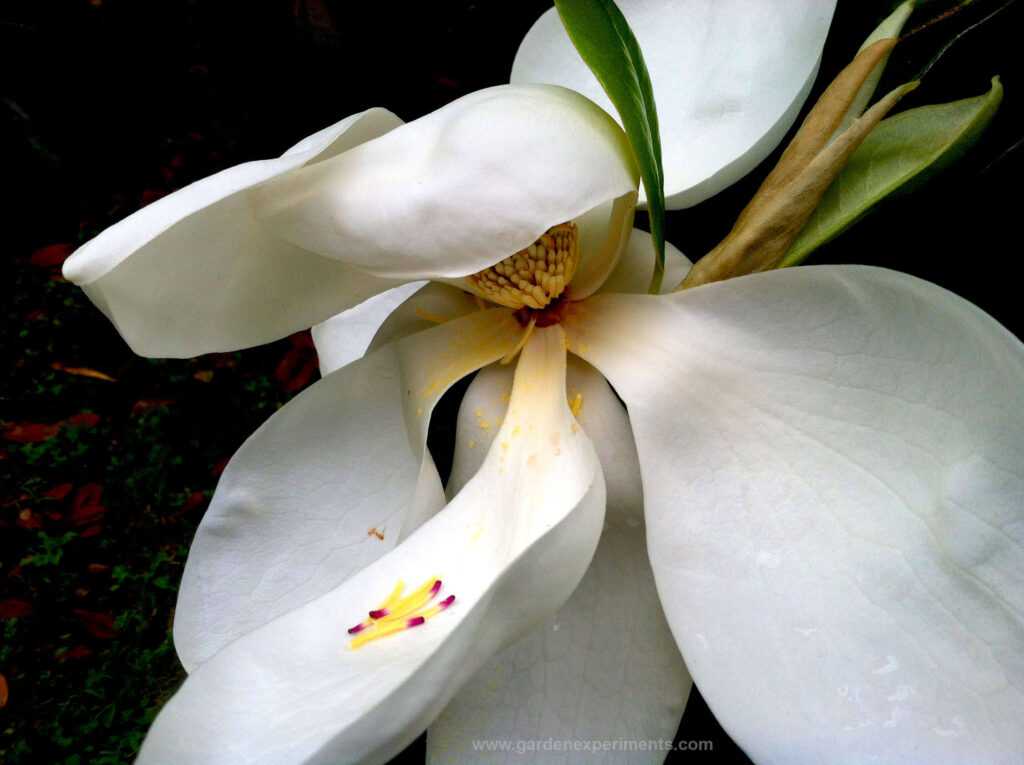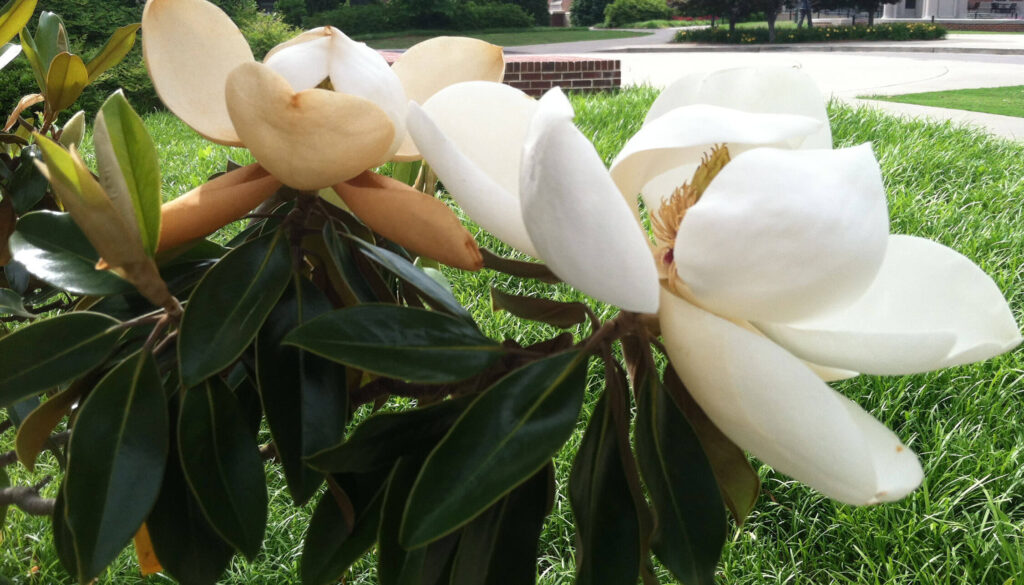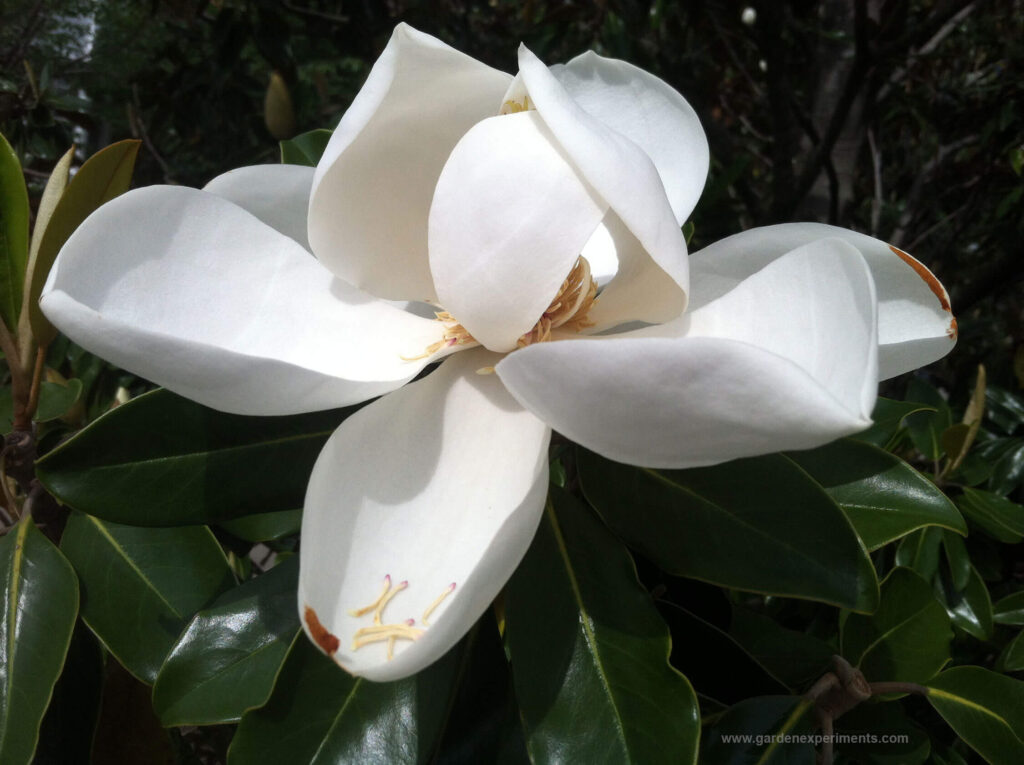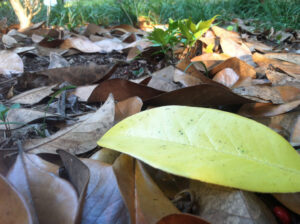You’ll see beautiful, tall southern magnolias anywhere you go in my state. They are nearly ubiquitous in front of antebellum homes in the South, which is a testament to their popularity during that time in our history.

I love the sweet, gentle lemon scent of the blooms and the large white petals. It’s a bonus that the trees are evergreen, so you’ll have greenery throughout the seasons. My only complaint about these stately trees is that they lose leaves throughout the year, and the leaves are difficult to compost without chopping them up.
But, if you don’t mind raking leaves and picking up the fruits before you mow, this is a beautiful tree to consider adding to your garden.
Plant Description
Southern magnolia trees can grow as tall as 90 feet with large trunks anywhere from a couple of feet (2-3) to 4 or so. They develop a deep tap root as they grow.
Leaves of the southern magnolia are thick and waxy on top with a thin fuzzy brown coating on the bottom of mature leaves. They are usually 5 to 8 inches long and 2-3 inches wide. The tree is an evergreen, so the leaves persist throughout the year. They are elliptical in shape with a point at the end. This tree sheds leaves throughout the year.
The flowers are quite large – 8 to 12 inches in diameter. They bloom from April to June and have a light, lemony scent.
Fruits are brown, cone-shaped, and have bright red seeds in them. Be sure to pick them up from your lawn before you mow, as they can become dangerous projectiles when shot out of a mower.
Native Range & USDA Hardiness Zone
Southern magnolias are native to the southeastern United States, from North Carolina to Texas. They are drought-tolerant and can be grown in full sun to part-shade in zones 7 to 9. There are many cultivars of this native tree. You can select the one that best suits your garden conditions.
Soil Moisture
The southern magnolia prefers moist, well-drained soil. It tolerates soil with a lot of moisture. It will grow in a variety of soils, including acidic, loamy, moist, sandy, and clay. It has a moderate to high drought tolerance, depending on root systems.

Wildlife Uses
The seeds of the southern magnolia are eaten by squirrels, opossum, quail, and wild turkey. This tree provides shelter for many birds. Magnolias are deer resistant.
Souther magnolias provide food, shelter, and refuge for a large number of insects. The leaf litter of the Southern magnolia provides habitat for insects and is the breeding ground for the leaf-footed bug (Source: Magnolia Society). Bees feed from the flowers.
Interesting Facts
The genus Magnolia is very old; it is one of the most ancient angiosperms (flowering trees). It existed 95 million years ago and persists today.
State Flower of Mississippi and Louisiana
MISSISSIPPI – In 1900, over 23,000 school children voted for the state flower. The magnolia received over 54% of the votes. It was officially named the State Flower by the Mississippi Legislature in 1952.
The National Champion southern magnolia is living in Smith County, Mississippi. It is 122 feet tall and over six feet in diameter. It was named by the American Forestry Association in 1986.
LOUISIANA – Designated the state flower in 1900, magnolias are abundant throughout the state.
Additional References
- http://www.floridata.com/ref/m/magno_g.cfm
- USDA silviculture manual on Magnolia grandiflora
- http://www.fs.fed.us/database/feis/plants/tree/maggra/all.html
- http://www.mfc.ms.gov/pdf/Pubs/38-07%20Southern%20Magnolia.pdf


